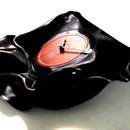Introduction: Joker Mosaic
One fine day, totally out of the blue, the startup I work with received a box overflowing with small stock image prints. Turns out we had purchased a few hundred images from Images Bazaar way back for a client's project, and they mailed us these prints for promotion.
Such an awesome opportunity simply cannot be allowed to be wasted and I volunteered to put these images to good use. I decided to make a mosaic of 392 images from these totally random 700-800 images(coincidentally, the stock images we bought were also used to make a digital mosaic).
Having never made a mosaic myself, I was informed that the mosaic making process is best left to computers, which can analyze each image, tint them and find the best spot to place them. Neither having such awesome processing power while doing it manually, nor willing to tint my images with markers(nor being an artist), I was told it's not possible. But being an obstinate idiot, I decided to trudge ahead and this instructable is the result of months of despair, rework, dropping the project, taking it up again, and the eventual euphoria of success. If you decide to follow my footsteps(maybe a family portrait mosaic from all the family photographs till date?), be warned it's going to be a roller coaster ride, but if I can do it, almost anybody can. This instructable is made to help out a bit.
Here's a time-lapse video of me making the mosaic:
If you are someone from Images Bazaar, thanks for the images and kindly take this in the maker spirit while basking in the glory of shameless plugs I've added on top. :)
Step 1: Stuff Needed
Loads of images. I have about 700-800 totally random images
A sheet of your preferred material. I used a spare polypropylene sheet lying about.
Generic white glue
Cyanoacrylate aka Super glue
A dab of paint (if you want to write something)
Imagination
Step 2: Choosing Your Mosaic Image
This requires a lot of thought. You cannot just pick up any image and make it a mosaic. Well, technically you can but then you will need thousands of images across a wide variety of color spectrum. Choose an image with as few colors as possible while having as little detail and as much contrast as possible.
After looking through a lot of iconic images of Bob Marley, Kurt Cobain, Jimi Hemdrix, Che Guevara, I finally settled on Joker from The Dark Knight because he has few but easily identifiable colors: green hair, white face, blackened eyes, red mouth and purple coat. So even if I didn't manage to nail the shape, the easily recognized color combination will help convey the image.
Step 3: Mapping Mosaic Image Into a Grid
Measure the size of your images. They should all basically be the same size. Note down the proportion of width to height.
Open up an image editing software. Using the proportion calculated earlier, make a box in a new transparent layer over the image. Duplicate it till you get an estimate of how many will be needed to fill up the width and how many are required to fill up the height of mosaic image. Multiplying the two figures will tell you how many images are needed to make your mosaic. Make sure the number is below half the images you have as you will be able to use less than half of them since most will not fit anywhere. If you want a more or a less dense grid, proportionately scale the boxes. Once size of box is set, divide the whole image into a grid using line tool.
Step 4: Sorting the Images by Color
The second most tiresome part is going through all the images. Take a good look at your images. By now I remember all the images I received and if I ever see one of the stock images being used somewhere, I'll recognize it immediately.
Identify all the major colors in your mosaic image. Mine were: green, white, black, red and purple. Then I needed to see which colors merge into each other. For example, The red lips will be surrounded by white of the face and a bit of black from neck's shadow. So I also need images with red+white and red+black. Black eyes will be surrounded by white face, so I need images with both black+white. So segregate all the images into heaps by their colors.
Step 5: Calculations for Centering Mosaic Image
Measure the dimensions of a single unit image. Mine were 4cm x 2.5cm.
Now count how many images make up the width and height of the grid you mapped to your image in Step-3. My grid has 14 images width-wise and 28 images height-wise.
Multiply the number of images in width and height of grid by the width and height of a single image to get the size of your mosaic image. So the size of my mosaic is 4*14cm x 2.5*28cm = 56cm x 70cm
Measure the dimensions of the sheet you will be using. Mine was 67.6cm x 88cm
Reduce from this the dimension of your mosaic image and divide by 2 to get the margin space required on either side to center the mosaic image. For me, ((67.6 - 56) / 2)cm x ((88 - 70) / 2)cm = 5.8cm x 9cm was the margin I got. I kept the top margin 5.8cm as well to leave out some space at bottom to paint text.
Step 6: Drawing the Grid
Using a pencil, draw a box for the image mosaic using the margins calculated in the previous step. Mark off points using width and height of individual images and divide it into the same grid as used for the digital mosaic image. Now you have a grid to place your images.
To get your bearings, add naming on top of your columns and rows with alphabets or numbers. Do the same for the digital image with grid. This way you can easily refer which grid you are working on both physically and digitally.
You can also lightly sketch the image onto the grid to help in the mosaic making process.
Step 7: Use Your Imagination
Now that all the preparations are done, here starts the hardest part. Theoretically, the only thing you have to do is find images that match your grid spots and place them there. Practically, it's a tedious process of sorting through all the images in the pile for the color required(thanks to making piles, you don't have to sort through ALL the images) for each grid location. Find the best match and stick it there with the smallest dab of weak glue. This is because an image will fit more than one locations and one location will have more than one candidate. You will be constantly removing, swapping or adding images to find the best combinations. There is no hard and fast rule for this step, just trust your own judgement.
You will be daunted by a lot of difficult and seemingly impossible tasks, but keep at it. When having to choose between matching color and matching color contrast, try to lean in towards matching contrast. For me, it was really difficult to make the part where top of the face meets the hair. Finding an image with white at bottom and green on top was near impossible as for all green-white images, green grass/trees are at the bottom of images and whitish sky is at the top. I was tempted to place them upside down, but I held fast.
There is no perfect arrangement. You can keep improving it and it will keep getting better. I was working on-and-off for months and it kept improving, getting subtle shades, a better nose, gradual color gradients etc.
Step 8: Finalize It
Once you are happy with the end product, one-by-one remove images, remove the glue residue and stick them permanently with superglue. That's what I'm doing in the video, I took off the images, marked their backsides with their grid locations and proceeded to stick them with superglue in pretty much the same order I took to make it initially, first working on the hair, followed by eyes, then mouth followed by working on face, nose, body and finally filling in the background.
Having never made a mosaic myself, I was informed that the mosaic making process is best left to computers, which can analyze each image, tint them and find the best spot to place them. Neither having such awesome processing power while doing it manually, nor willing to tint my images with markers(nor being an artist), I was told it's not possible. But being an obstinate idiot, I decided to trudge ahead and this instructable is the result of months of despair, rework, dropping the project, taking it up again, and the eventual euphoria of success. If you decide to follow my footsteps(maybe a family portrait mosaic from all the family photographs till date?), be warned it's going to be a roller coaster ride, but if I can do it, almost anybody can. This instructable is made to help out a bit.
Belonging from a technical background and this being my first instructable in the art category, I took a lot of time and effort. A practicing artist could do it better and/or in way less time. :)

Participated in the
Wall Overhaul

Participated in the
Halloween Decor Contest

Participated in the
Superheroes and Supervillains Contest













